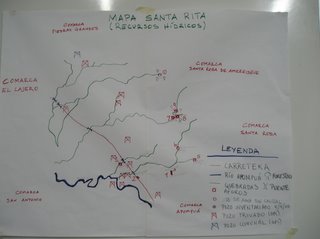Semana Santa - Easter week
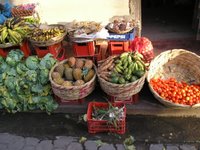 WHO: Essa (aka Vanessa)
WHO: Essa (aka Vanessa) WHAT: Peace Corps, Environmental Education
WHERE: Nicaragua
WHEN: Sept '05 - Nov '07
WHY: La vida es un carnaval.
Semana Santa __________
I took advantage of Semana Santa to visit Noemí in her site about
3 hours north of me. It's much cooler there - and her town is tiny! The cicadas are deafening at this time of year - we practically had to yell at eachother at times to talk.
Here's a market scene from the town where I had to change buses:
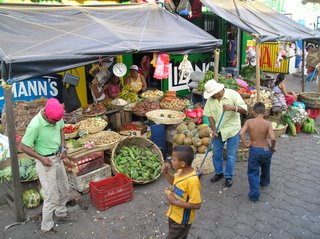 There are vehicle roads on either side of her town, and a few very rough ones within the town limits, but mostly there are just trails going from house to house and to the church. There are no stores - some people convert one room of their house into a little shop where you can buy staples. Otherwise, you have to travel the 15K to the market. Here's he road out of town.
There are vehicle roads on either side of her town, and a few very rough ones within the town limits, but mostly there are just trails going from house to house and to the church. There are no stores - some people convert one room of their house into a little shop where you can buy staples. Otherwise, you have to travel the 15K to the market. Here's he road out of town.
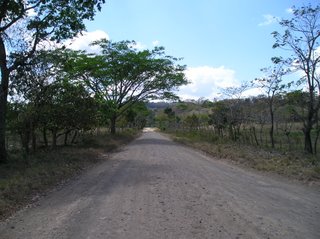
The reservoir that was built to serve the town of Cuapa (where the market is). It's just outside of Noemí's community.

Noemí and her chavalos (little boys) in front of her alegre house. It was painted this lovely shade of orange just before she moved in. The interior is just as alegre.
 The view from Noemí's front door.
The view from Noemí's front door.

Li li is on the left, and is the mother of Nico, which is Noemí's hound.
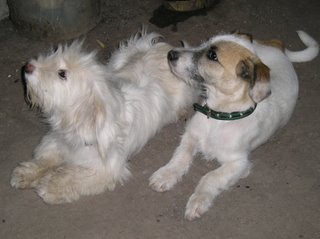 Making pasta....
Making pasta.... This is Noemí's neighbor and best friend in her community. She's making pinolio, a type of corn based drink that we had with our beans and rice.
This is Noemí's neighbor and best friend in her community. She's making pinolio, a type of corn based drink that we had with our beans and rice.
Moonrise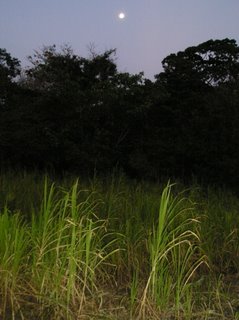 This is the church. The town is predominantly Catholic, though the Evangelical's are busy doing their work in the community. The church was nearly destroyed in Hurricane Mitch in '98, and only parts of the original structure are remaining.
This is the church. The town is predominantly Catholic, though the Evangelical's are busy doing their work in the community. The church was nearly destroyed in Hurricane Mitch in '98, and only parts of the original structure are remaining. The front facade is original, though now it has a zinc ramada-like roof, and they've run out of money, so it's pretty much open air.
The front facade is original, though now it has a zinc ramada-like roof, and they've run out of money, so it's pretty much open air.
 An altar that was built in celebration of Semana Santa.
An altar that was built in celebration of Semana Santa.One of the women helping to build altars at the church.
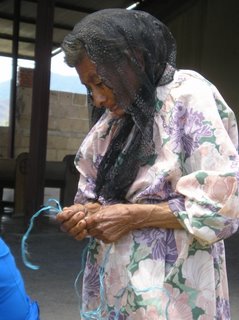 View from the church doorway. The peak is where, evidently, a long time ago, someone saw the devil. The priest put a cross up there and now, every May 3rd, the townspeople go up there. I'm sure at one point it was a religious event, but now we've heard that the purpose has changed over the years...now there's more guaro (rum) drinking than bible reading.
View from the church doorway. The peak is where, evidently, a long time ago, someone saw the devil. The priest put a cross up there and now, every May 3rd, the townspeople go up there. I'm sure at one point it was a religious event, but now we've heard that the purpose has changed over the years...now there's more guaro (rum) drinking than bible reading.
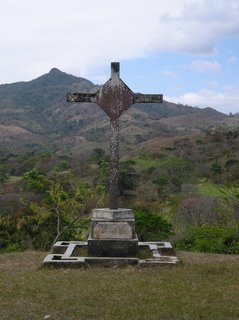 On one of our walks we saw a perezoso (lazy bear or sloth!) Noemí pases is every time she goes to one of her schools. I really wanted to see one while I was here in Nicaragua. We were hoping it might wake up so we could see its face, but no luck. It just slept. It was in the same position an hour later when we walked by it again.
On one of our walks we saw a perezoso (lazy bear or sloth!) Noemí pases is every time she goes to one of her schools. I really wanted to see one while I was here in Nicaragua. We were hoping it might wake up so we could see its face, but no luck. It just slept. It was in the same position an hour later when we walked by it again.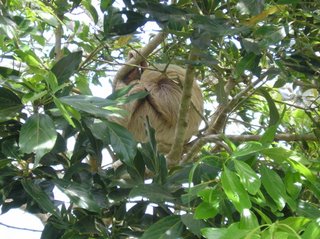 Doña Reina's house_________________________
Doña Reina's house_________________________
Within the rural community where my school is, there is a woman, Doña Reina, that is helping us create a school garden. Evidently, a Dutch NGO came through the community about 8 years ago, to teach the people how to reforest and garden. They gave the people some training, tools, and seeds, and Doña Reina is the only one who has stuck with it. She is very knowledgeable and a great resource for the school. I love going to visit her - below shows two boys on the trail to her place. One has to ford a stream (which can turn into a raging river during the rainy season) to get to her house. She uses the roots of a huge tree to navegate the stream embankment. A feat she thinks nothing about as she nimbly picks her way either barefoot or with plastic flip-flops

Here is their house. Doña Reina is in the white, and her daughter (also Reina) is taking clothes off the line.
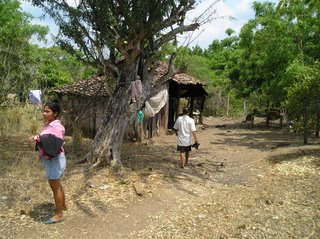
She was kind enough to give us some tomato, squash, and carrot seeds from her supply for our garden.
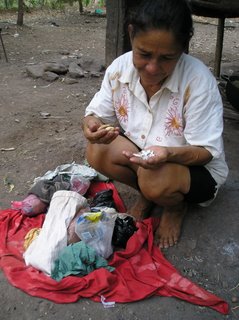 Her tree nursery
Her tree nursery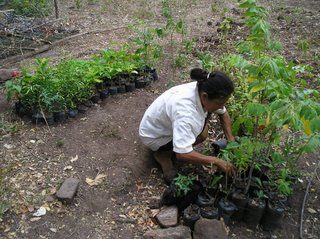 This is the chocoyo that sits on a branch outside their house sqauking incessantly .
This is the chocoyo that sits on a branch outside their house sqauking incessantly .
 Kids __________________________________
Kids __________________________________
Céline lent me a couple of her oragami books her aunt sent her from France (of course, they were in French) and in my youth group, the girls made chats. They had a great time - and then we played semaforo rojo - semaforo verde (red light green light). I've been working with the library and the local Franciscan school plan a save-the-trees parade. Last week, I worked with a group of 11 San Francican students - we walked around town visiting all the high school classrooms inviting them to participate in the parade. They are excited about the project, and are hoping for a large turnout.
I've been working with the library and the local Franciscan school plan a save-the-trees parade. Last week, I worked with a group of 11 San Francican students - we walked around town visiting all the high school classrooms inviting them to participate in the parade. They are excited about the project, and are hoping for a large turnout.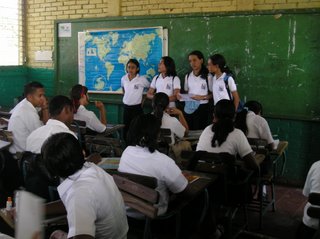

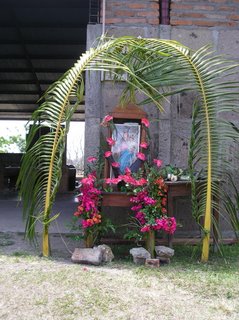




 I'm involved in a water resource inventory project in a nearby subwatershed near my city. It is lead by a Dutch NGO, but with the hopes that the BLM equivalent agency will run with it in setting up their watershed management plan. It will also help farmers in the watershed work together in protecting their water. Representatives from each of the ministries involved in land management were there, and we spent a few days learning about the project and how to do an inventory.
I'm involved in a water resource inventory project in a nearby subwatershed near my city. It is lead by a Dutch NGO, but with the hopes that the BLM equivalent agency will run with it in setting up their watershed management plan. It will also help farmers in the watershed work together in protecting their water. Representatives from each of the ministries involved in land management were there, and we spent a few days learning about the project and how to do an inventory.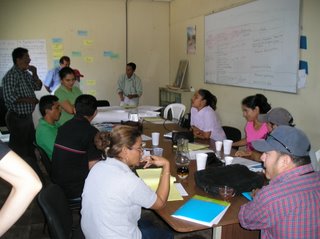

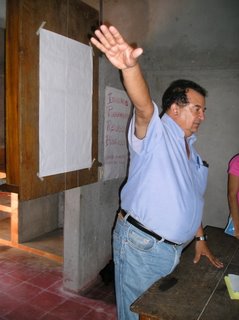 Community members making a sketch of the land - later to be used as a field map.
Community members making a sketch of the land - later to be used as a field map.


 Back at the office working late into the night to complete the maps for presentation to the community. Stress was high as the days were long and I think people felt like there were too many cooks in the kitchen. But we got it done.
Back at the office working late into the night to complete the maps for presentation to the community. Stress was high as the days were long and I think people felt like there were too many cooks in the kitchen. But we got it done.
